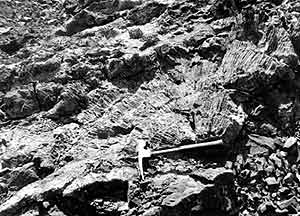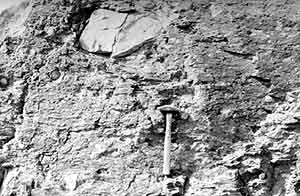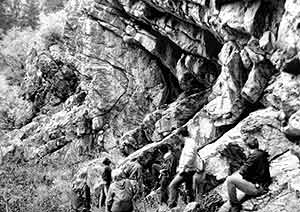|
Page
13
|
Rocks of the Eastern Idaho Mountains:
Late
Proterozoic Sedimentary Rocks
The oldest rocks in the
southeast Idaho thrust belt belong to the Pocatello Formation (750 to 700 million
years old), which is exposed in the Bannock Range from the Pocatello area south
through Oxford Mountain and almost to the Utah border. The Pocatello Formation
contains two unique rock types, metamorphosed basaltic lava or greenstone, and
dark-brown or gray rock known as diamictite, which contains clasts of older
rocks, ranging from pebbles to boulders in size, floating in a matrix of sand
and clay. Some of this diamictite was deposited as glacial-marine till.
 |
| Fossil of intact head of colonial coral Favosites, Permian Snaky Canyon Formation, east side of Lost River Range, (July,1990). |
Some of the micaceous quartzite or "Oakley stone" found on the flanks of the Albion Range south of Burley is probably correlative to parts of the Brigham Group. The distinctive bright green Elba Quartzite, now quarried at Park Valley, Utah, is older, of Middle Proterozoic age. It has been metamorphosed so that the chromium rich clay minerals have recrystallized to green, shiny plates of mica.
 |
| (above) Diamictite, or pebbly mudstone, of the Scout Mountain Member of the Pocatello Formation north of Portneuf Narrows. Note quartzite boulder above head of hammer. These rocks were deposited by glacial marine ice sheets about 750 million years ago when North America was attached to Antarctica or Australia, and Idaho was apparently in a low latitude, (July, 1979). |
 |
| Overturned syncline in Cambrian and Late Proterozoic Camelback Mountain Quartzite, Brigham Group, in Mill Creek, south of North Putnam Mountain, Fort Hall Indian Reservation, (September, 1986). |
Paleozoic
Limestones and Sandstones
A thick sequence
of carbonate rocks (limestone and dolomite), of early Paleozoic age (530 to
300 million years) lies above the Brigham Group and is present in most of the
mountains of eastern Idaho. These rocks were deposited on broad carbonate platforms
in warm seas off the western edge of the paleo-North American continent, settings
not dissimilar to today's Bahama Banks or Great Barrier Reef. In many places
the Paleozoic limestones contain invertebrate fossils, including trilobites,
bryozoans, brachiopods, corals, and molluscs, which allow determination of their
age and the precise conditions under which they were deposited.
Surface streams are rare in the limestone country. The limestone cliffs are highly porous and most of the water sinks into the subsurface. In places extensive cavern systems exist, as at Minnetonka Cave west of St. Charles. Large springs form where the subsurface water (groundwater) intersects the land surface. Such springs supply important parts of the municipal water supplies of southeast Idaho. They are easily contaminated and their purity must be guarded carefully.
Thin units of fine-grained sandstones or quartzite are present within this stack of Paleozoic limestones in the Swan Peak Quartzite of Ordovician age and the Wells Formation of Pennsylvanian age. These sandstones represent times when wedges of quartz sand, eroded from distant mountain ranges, prograded over the carbonate platforms.
Also present in some limestone units are gray and black chert beds and nodules, which weather to distinctive pebbles of hard flint. This chert formed from dissolved skeletons of silica-secreting invertebrates, which also existed in the warm shallow seas.
Some of the limestone has been altered to the crystalline carbonate rock dolomite. In this process original fossils are generally destroyed and the result is a light or dark gray rock that preserves bedding structures but little of the fine detail found in limestone.
Mesozoic
Continental Strata
Rocks of Mesozoic
age in the southeast Idaho thrust belt include thick limestones of Triassic
and Jurassic age and even thicker sandstones and shales of Cretaceous age. They
were deposited before and during the thrust deformation, in basins which subsided
because they were loaded down by the weight of advancing thrust sheets. These
rocks are exposed on Highway 89 east of Montpelier, and on the Tincup highway
east of Wayan, but the most spectacular place to see Mesozoic rocks is Raymond
Canyon, Wyoming, just south and east of Geneva, Idaho.
Soft
Cenozoic Rocks in the Valleys
The rocks that partially
fill the valleys of southeast Idaho differ in fundamental ways from those that
underlie the mountains. First, the valley fill is predominantly young, less
than 10 million years old, and contains the imprint of volcanic activity associated
with the Snake River Plain. There are large quantities of tuff, a distinctive
white sedimentary rock made of collapsed shards of glass and derived from clouds
of ash given off by volcanic eruptions on the Snake River Plain. Other parts
of the valley fill are conglomerate, often with a red matrix. These coarse-grained
rocks were carried by streams from adjacent mountains and deposited as the valleys
were lowered along range-bounding faults. Lacustrine limestones also make up
parts of the valley fill.